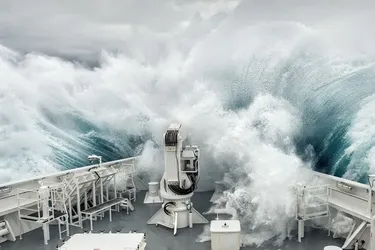The most dangerous part of the world's oceans: where on the planet waves reach 25 meters

The Drake Passage is an oceanic channel located between the southern coast of South America and the West Antarctic Peninsula. Named after the 16th century explorer Sir Francis Drake, this strait is famous for its incredibly strong storms and huge waves up to 25 meters high.
This is reported by Live Science. The Drake Passage connects the Atlantic, Pacific, and Southern Oceans and, as Alfred Lansing noted in 1959, is "the most terrifying part of the ocean on the planet." Its width is about 965 kilometers, which makes the strait quite narrow compared to the oceanic expanse that surrounds it.
The researchers note that due to the limited width of the channel, currents accelerate as they pass through it. The same applies to the southerly winds, which move freely from west to east around Antarctica until they reach the Drake Passage.
In 2024, Karen Haywood, a professor of physical oceanography at the University of East Anglia, crossed the Drake Passage. According to her, this place can be characterized as a "melting pot" for the currents of the Atlantic, Pacific and Southern Oceans. The waters here are so turbulent that the layers of water that are usually distributed across the seas mix with each other. This contributes to the fact that the Strait absorbs much more carbon than other parts of the ocean.
It is known that the world's oceans are one of the largest carbon reservoirs on the planet, holding about 30% of all carbon emissions that humans release into the atmosphere. Scientists now believe that the Drake Passage may be one of the few places where this process is particularly pronounced.
The Drake Passage also plays a key role in keeping Antarctica cold by separating warm air that would otherwise enter from South America. Research suggests that the opening of the Drake Passage between 49 and 17 million years ago was a factor in causing significant cooling in Antarctica and contributed to the formation of huge ice sheets on the continent.
According to Alberto Naveira Garabato, a professor of physical oceanography at the University of Southampton, the temperature drop when passing through the Drake Passage can be seen even on ships. The researchers concluded that the extreme winds and currents that make traveling through the Strait very dangerous for ships actually play an important role in protecting Antarctica by helping to maintain its cold climate. Simulations also show that without the Drake Passage, Antarctica would lose a significant portion of its ice cover.
Earlier, we told you that the Earth' s most powerful ocean current is preparing a dangerous surprise for humanity.
If you want to get the latest news about the war and events in Ukraine, subscribe to our Telegram channel!
